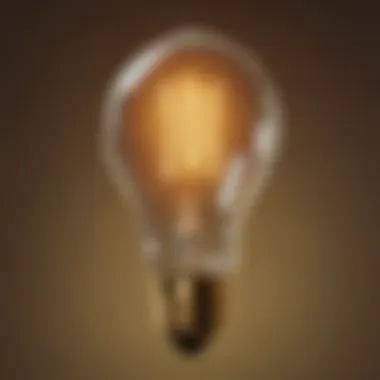The Light Bulb: A Bright Idea That Illuminated History


Intro
The invention of the light bulb represents a pivotal moment in human history. It embodies not simply a tool for illumination, but also a profound catalyst for societal transformation. In understanding its significance, we explore it's journey—beginning with early attempts at electric light, through the breakthroughs accomplished by notable inventors, to the pervasive impact this innovation has on our daily lives.
Science Fun Facts
The light bulb is steeped in intriguing trivia. These facts reveal why this invention has captivated people's imaginations for over a century.
- The First Light Bulb: Thomas Edison is often credited with inventing the light bulb. However, several inventors, including Humphrey Davy and Joseph Swan, also contributed to its development.
- Longevity of Bulbs: The first long-lasting light bulb, made in 1901, was said to have been lit continuously for over 91 years. It still shines today without needing a replacement!
- Secret Behind the Glow: Incandescent bulbs work by heating a thin filament inside, while newer technologies, such as LED bulbs, use semiconductors to produce light more efficiently.
"A great invention is a mind that has greatly accessed the potential of both science and creativity."
- Current Influence: More than 130 years after its creation, the light bulb is still evolving. Today, compact fluorescent lamps and LED technology are more energy-efficient and eco-friendly options.
These fun facts not only highlight the light bulb's innovative essence but also provide insight into its rich historical background.
Discover the Wonders of Science
As we survey the scientific principles guiding the light bulb's existence, several concepts can deepen our understanding begins to unfold. From the interactions of electrons in a filament to the advancements in materials science for better energy efficiency, the mysteries of light extend into everyday life.
- Exploring Concepts: Consider how electricity travels and how chemical energy gets transformed into light. The principles are applicable across various technologies.
- Educational Resources: Video demonstrations available online can illustrate these electrical concepts in action. Viewing these reveals not only the science behind how light bulbs function but can also engage curious minds about related topics.
Science Experiment Showcase
For those eager to investigate further, simple experiments can elucidate the principles of light and electricity.
- Experiment Idea: Create a basic circuit using batteries and a small bulb. This allows hands-on learning about how electricity flows.
- Instructions:
- Safety Tips: Always ensure safety while performing experiments. Adult supervision may be necessary to avoid any hazards associated with electricity.
- Gather materials such as battery, wires, and a simple light bulb.
- Connect the wires to the battery and then to the bulb.
- Observe what happens when connections are secured.
The Historical Context of Electricity
Understanding the historical context of electricity is essential to grasping the development of the light bulb. The evolution of electrical theories and discoveries paved the way for future inventors, making significant contributions that ultimately allowed for a functional light source. These early realizations about electricity proved crucial in wielding a force that would significantly alter society.
Early Discoveries in Electricity
The journey into the world of electricity began long before the light bulb became a reality. It started with ancient civilizations who noticed phenomena such as static electricity when amber was rubbed with wool, as documented in ancient Greece. However, electricity gained more scientific attention during the 17th century. In 1600, William Gilbert published a detailed study titled De Magnete, where he explored electrostatic forces and magnetism, laying foundational concepts of electricity.
By the 18th century, scientists like Benjamin Franklin began experimenting with electrical phenomena. Franklin's noteworthy kite experiment demonstrated the electrical nature of lightning, leading to his invention of the lightning rod. His contributions achieved a deeper understanding, essential for further research in electricity.
Further discoveries continued into the 19th century with figures like Alessandro Volta and Michael Faraday. Volta created the first chemical battery, known as the voltaic pile, providing a reliable and continuous power source. Faraday’s groundbreaking work on electromagnetic induction allowed energy to be generated from motion, which later influenced how electricity could be harnessed.
This growing understanding of electricity cultivated an environment ripe for innovation. It was the synergistic interplay between these early discoveries and technological advancements that would later impact light bulbs directly.
The Role of Scientific Experimentation
Experimentation has always been central to technological progress. The development of electricity did not occur in isolation; it was the result of methodical experiments conducted by numerous scientists. Through their trials and errors, they gradually revealed the properties and potential uses of electricity.
One key figure in this experimental landscape was Michael Faraday. His laboratory was a sanctuary for groundbreaking work, where he tested and confirmed theories surrounding electromagnetic fields and induction.
Moreover, Thomas Edison who would later become immortalized through his work on the incandescent light bulb, also advocated for systematic testing. His methodical approach, alongside the concept of failure as part of the process of discovery, made it possible to finally bring the light bulb to life.
Thus, the stage was set for the invention of the light bulb. Society's increasing interest in using electricity necessitated appliances and tools powered by it, steering efforts toward crafting a reliable lightsource. The work leading up to the light bulb highlighted not only electricity's principles but also a societal yearning for illumination and advancement.


Key Inventors of the Light Bulb
The invention of the light bulb is a pivotal moment in modern history, influenced by several key inventors whose contributions were crucial in shaping its development. Understanding their roles elucidates how incremental advancements made a significant impact over time. Each inventor brought a unique perspective and skill set to the table, showing that innovations tend to be the product of multiple minds rather than a single individual.
In the realm of electrical engineering, the inventors of light bulbs not only designed devices for illumination but also addressed technical challenges and efficiencies, laying the foundation for society to shift toward electric lighting. This transformation ushered in substantial changes in everyday life, industry, and even the arts.
Sir Humphry Davy and the Arc Lamp
Sir Humphry Davy was an early pioneer in the field of electric light. His demonstration of the arc lamp in 1809 marked the beginning of attempts to create artificial illumination through electrical means. Davy connected carbon rods to a powerful battery. The extremities of these rods glowed intensely when a current flowed between them, producing light. While Davy's arc lamp was not practical for widespread use due to its size and brightness, it sparked interest in electric lighting. This pivotal moment marked the footstep toward understanding how electricity could create light.
Joseph Swan's Contribution
Joseph Swan, a contemporary of Thomas Edison, made substantial advancements in the search for an effective incandescent light bulb. By 1878, he successfully demonstrated a working electric lamp. Swan’s approach focused on carbonized paper as a filament. His design produced light more efficiently than previous models, paving the way for commercial applications of incandescent lighting. The accolades that came from his initial brilliantly illuminated room demonstrated the potential of electric light.
Thomas Edison: A Household Name
Everyone recognizes the name Thomas Edison, and for good reason. In 1879, Edison improved upon existing designs to create an incandescent bulb that could last over 1,200 hours. This breakthrough came not just from innovation but also from meticulous experimentation. Edison's choice of carbon filament was a critical factor; he conducted science with methodical precision, leading to profitable manufacturing. Under Edison's banner, the light bulb revolutionized our homes, illustrating the capabilities of electric light and making it accessible to the average citizen.
"Edison wasn't just an inventor; he was a team player who recognized the value of collaborating with experts, amplifying the impact on light bulb technology."
Edison's name has since become synonymous with the light bulb itself, and today, he stands as a symbol of what focused effort and creativity can achieve. The groundwork laid by these key inventors weave a rich tapestry that illustrates the evolution of electric light, demonstrating how crucial it was for the societal changes that followed.
How the Light Bulb Works
Understanding how the light bulb works is not only important for appreciating this invention but also crucial for grasping how electrical energy transforms into light. The process involves various principles of physics and technology that reveal the intricacies of illumination.
Basic Principles of Electrical Circuits
Electrical circuits are the backbone of how light bulbs function. At a core level, a circuit is a path through which electric current flows. This flow occurs when two or more components, like a power source and a light bulb, are connected.
Here's how it works in simple terms:
- Power Supply: The circuit needs a power supply, which could be your home's electrical system or a battery. This creates the electric potential that pushes current through the circuit.
- Wiring: Conductive materials, generally copper wires, carry the electric current from the power supply to the light bulb.
- Load: The light bulb acts as a load in the circuit. It converts electrical energy into light through processes that occur within its structure.
For an incandescent bulb, current enters through a thin filament. When the current flows through it, this filament heats up and eventually produces light as a result of incandescence.
Key Takeaway: The transformation of electric energy into light happens through the interaction between components in the circuit.
Incandescent vs.
LED Technology
Incandescent and LED technologies represent two distinct approaches for producing light. Each has unique characteristics that contribute to their application in different settings.
Incandescent Light Bulbs:
- Produce light by heating a metal filament until it glows.
- Typically, consume more energy for less light output, resulting in greater heat loss.
- Ideal for situations requiring warm light but are becoming less common due to inefficiency.
LED (Light Emitting Diode) Bulbs:
- Generate light through electroluminescence, using a semiconductor material.
- Much more energy-efficient, saving power while providing bright illumination.
- Have a longer lifespan and produce less heat, making them better suited for modern lighting requirements.
The Impact of the Light Bulb on Society
The light bulb is much more than an object that brings brightness into our homes. Its invention represents a pivotal moment in human history, profoundly altering the structure of society. The relevance of the light bulb can't be overstated. It reshaped how people lived, worked, and even thought. The influence of this technological advance extends beyond mere illumination. It fosters energy society used to operate and innovate.


Transforming Daily Life
Before the electric light bulb, humans relied on natural light during the day and simple oil lamps or candles at night. Such limitations dramatically shaped daily routines. Families used to eat dinner before dusk, limiting nighttime activities. The advent of the light bulb liberated people from these restrictions.
Individuals could now gather after sunset. More activities appeared, such as reading or playing games at home.
With electric lighting, shoppers were no longer stranded by the setting sun, enabling longer hours in storefronts. This convenience arguably changed consumer behavior and promoted a nightlife culture. Yet, this comes at some environmental costs. The demand increased for electricity generation, leading to a need for sustainable sources.
Role in Industrialization
The industrial revolution went through significant changes with the introduction of the light bulb. Instead of relying on natural light, factories began working around the clock. The democratization of electric lighting allowed industries to maximize productivity. Jobs could be filled with altered schedules. This change created countless job opportunities and fueled an unprecedented pace of manufacturing.
Now, with machines lit during night shifts, industries saw an increase in output. The economic growth spurred by constant accessibility to lith gt now led to urbanization. People flocked to cities seeking jobs. This migration transformed the demographic landscape and strengthened the economy.
Cultural Shifts After the Light Bulb
The light bulb brought more than practical effects; it ushered in an array of cultural shifts. New opportunities in art, literature, and social gatherings began blossoming. Locations once unseen by daylight found a recreation.
Nightclubs and theaters became common, enhancing social life immensely. People connected with one another through events happening at night. Significant cultural movements had energy. This interaction shaped people's thoughts, ideas, and abilities to think innovatively.
Art became filled with bright settings, capturing the charm of lights in works. Authors began illustrating modern life experiences helped by luminance that helped enhance late-night intellectual debates and discussions. This mix of impact fundamentally shifted public perceptions.
With such vast changes, it is told that the light bulb's introduction has revolutionized human experience across multiple dimensions.
Challenges Faced in Light Bulb Development
The journey of the light bulb involved several challenges. These impediments were not just physical issues but also complex economic and commercial conflicts that shaped its development. Understanding these challenges gives clarity on the persistence and ingenuity of inventors. The complexity faced by those who developed the light bulb illustrates the importance of overcoming obstacles for innovation to flourish.
Technical Limitations
In the early stages, developing a functional light bulb faced severe technical limitations. Materials typically failed to sustain the heat produced by electricity. For instance, Thomas Edison experimented with different filaments. Early prototypes could not remain lit for long without burning out. Their lack of durability was a significant hurdle. It took time to find materials that could handle both the heat and sustained electricity.
A key breakthrough came with the introduction of carbon filaments, which were more resilient but also complex to manufacture. The understanding of electrical resistance played a role. Different materials backed by solid scientific principles were explored.
Through persistent experimentation, Edison and others initiated a new era of understanding electricity about materials. The progress was gradual and often disheartening. However, these struggles led to smarter engineering practices that spread across industries beyond lighting.
Market Competition
The light bulb’s emergence did occur in a competitive market. Highlighting the tussle between inventors showcases how competition can drive innovation, regardless of market acceptance. Various inventors constantly struggled for patent ownership and commercial validation. Joseph Swan’s successful market entry with his own patent created tension with Edison, who was determined to make his version widely accessible.
This rivalry ignited a sequence of events filled with legal battles over patents, which affected many inventors' progress in getting products into the market. Potential monopolistic risks also raised broader public concerns about fair competition. Various technologies were developed at higher costs due to legal complications. Consumers and businesses had to navigate options, often being overwhelmed by too many choices.
In time, this market competition led not only to advancements in bulb technology itself but also to associated innovations like improved wiring systems and power generation methods. Therefore, the interplay of rivalry played a crucial role in pushing the boundaries of what was previously believed possible.
Modern Innovations in Lighting
Modern lighting has come a long way since the invention of the light bulb. With technological advances, the way we think about light now spans energy efficiency and smart technology. These changes are particularly significant in today's world where energy conservation and efficient usage are becoming paramount repeatedly.
Energy-Efficient Alternatives
Energy-efficient lighting options, such as LED bulbs and compact fluorescent lamps, have transformed how we illuminate our homes and workplaces. Unlike traditional incandescent bulbs, which convert most energy into heat, energy-efficient alternatives are designed to use less power while providing the same level of brightness.
Benefits of energy-efficient alternatives include:
- Reduced energy bills: Switching to LED bulbs can save families significant amounts on their electricity costs.
- Longer lifespan: Energy-efficient bulbs last much longer than traditional bulbs. This means less frequent replacements and less waste.
- Environmental impact: Using less energy reduces our carbon footprint. It is at the core of contributing to sustainable farming practices.


Now most people speedily understand and dominate the benefits of energy-saving lighting. From households to large-scale corporate offices, energy-efficient lighting has become an essential consideration.
Smart Lighting Technology
Smart lighting technology promises even more convenience and flexibility. Me technologies integrated into how we connect and control okur lighting systems have progressed. We have introduction of systems that allow users to manage their lights via smartphones, tablets, or computer applications.
Features of smart lighting technology often include:
- Remote control: Users can turn their lights on and off from anywhere, even when not at home.
- Customizable settings: Dimming options or scheduling time for challenging can easily accommodate diverse lifestyles.
- Integration with smart home systems: Many of these lights can integrate with systems like Amazon Alexa or Google Home.
Color-changing features can create different moods for various occasions, such as movie nights or family gatherings. Such potent innovations in lighting further endorse clever designs that can contribute to overall energy efficiency while meeting the diverse needs of modern users.
"Guardian with energy efficiency and touch on smart technologies is shaping our bright future in ways we'll keep finding out for years."
As lighting advances continually prioritize user experience, the repercussions of these innovations will stand long into the future, as they shape how we interact with environmentally sustainable electricity.
The Future of Lighting Technology
The future of lighting technology is an area that demands our attention. As society continues to evolve rapidly, the way we light our spaces must keep pace with innovation and environmental concerns. This section explores the significant aspects related to upcoming trends and development opportunities in lighting systems. Here, we assess sustainable practices and the prospects for potential tomorrow's innovations.
Sustainable Practices in Lighting Development
Sustainability is a crucial factor when discussing the advancements in lighting technology. As concerns regarding climate change escalate, there is a pressing need for energy-efficient lighting solutions. Using LED technology can greatly minimize energy consumption while maximizing illumination.
Adopting sustainable practices also means that manufacturers focus on environmentally friendly materials. They are pivoting towards biodegradable and recyclable elements to create light sources that are less harmful to our surroundings.
Some remarkable sustainable practices include:
- Use of Renewable Resources: Innovative companies turn to solar power to create solar-powered lights suitable for outdoor use.
- Recycling Programs: Light bulb recycling programs aim to limit electronic waste and ensure materials like glass and metals are reused.
- Smart Lighting Systems: Developing systems help save energy by using sensors to adjust brightness based on the time of day or user presence, contributing to a significant reduction in energy use.
These sustainable methods not only lower energy bills but also promote a broader cultural shift towards environmentally-responsible living. The integral importance lies in balancing modern conveniences with our planetary health.
Proper lighting choices enhance life quality, promote safety, reduce expenses, and respect the ow environment.
Potential Future Innovations
Looking at potential future innovations, lighting technology is, indeed, set to transform how we understand and utilize it today. Researchers and engineers are working on cutting-edge advancements that could further revolutionize the industry. Some promising innovations that could redefine lighting include:
- Organic Light Emitting Diodes (OLEDs): These are thin, flexible light panels that may enable new design possibilities for light sources, creating seamless integration with walls and surfaces.
- Li-Fi Technology: This advancement uses visible light for high-speed data transfer, revolutionizing how we think about lighting not just as a means to illuminate, but also as a communication tool.
- Smart Materials: Researchers are exploring smart materials that can change properties based on environmental factors. For instance, luminescent materials will adjust their brightness according to surrounding light levels.
Culmination: Lessons from the Light Bulb
The invention of the light bulb is not just a historical moment. It is a continuous lesson on the power of innovation and perseverance. Understanding this impact provides clarity on how ideas morph and evolve through trials. Light bulbs have allowed us to see in the dark but they also reveal the brighter aspects of human creativity. Each lighting source tells a story of what can be achieved.
The Importance of Innovation
Innovation is vital in a world that constantly evolves. The light bulb exemplifies how a simple concept can spawn major advancements. With each iteration of the light bulb, inventors pushed boundaries further. Edison's work with carbon filaments paved the way for the design of more efficient and longer-lasting bulbs.
The idea of how to illuminate our world represents a deeper resolve to seek solutions and adapt to society’s needs.
Each new lighting technology brings effortless savings and improvement in our everyday life.
- Optimization: New designs optimize energy consumption.
- Accessibility: Innovation enhances access to lighting in various regions.
- Quality of Life: Better lighting contributes to enhanced safety and productivity.
Reflections on Human Ingenuity
Light bulbs reflect a pinnacle of human ingenuity. Many minds contributed to reaching the final product we use today. Each creator faced challenges that pushed them for sophisticated solutions.
- Determination unites the world: Ingenious strategies emerge from efforts made to address real problems. During the development of electric light, inventors aimed to reduce accidents caused by flame-based lighting methods. This dedication exemplifies the commitment to safety and practicality, revealing deeper motivations.
- Learning from failures: Each misstep in the experimentation led to learning and ultimately significant breakthroughs. As an example, attempts to build a functional light bulb known as the incandescent solution taught countless useful lessons in how materials behave with electricity. This applies even in modern projects; people gain knowledge continuously, reflecting the pursuit of becoming better.
- Collaboration makes stronger results: The merging of different minds leads to richer innovations. Early experimenters communicated with each other, shared knowledge and resources, effectively laying the backbone on which today’s lighting envisions stand.
In summary, the light bulb serves not just as a fixture in homes and offices, but as a powerful metaphor for progress and sustainability within our ever-changing environments. It encapsulates various elements of creativity, resilience, and learning that will undoubtedly influence future generations.







